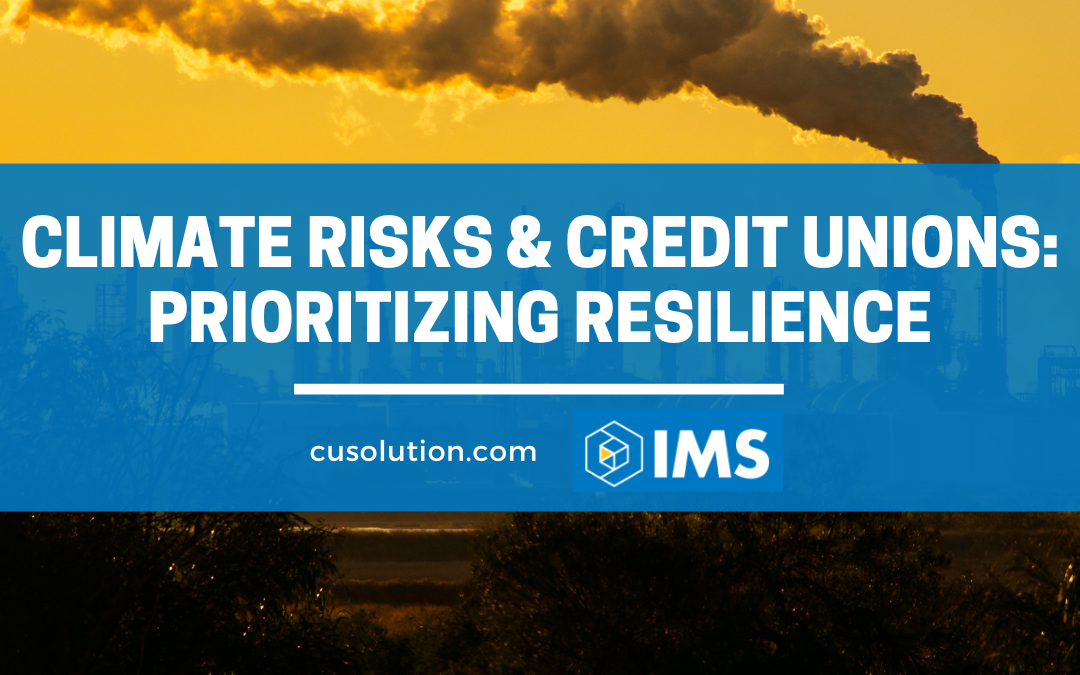Climate risks, once distant scenarios or hypotheticals, have now become clear and present realities. From devastating wildfires to destructive storms, rising sea levels, and recurrent floods, these challenges pose serious threats to the business continuity of credit unions.
Credit unions have always been at the heart of the communities they serve, a local presence that taps into their financial needs. Unfortunately, this also leaves them vulnerable to climate impacts. These physical risks are closely linked with financial risks, and as we grapple with the destructive wake of environmental disasters, credit unions are called upon to support the recovery of these communities.
Diving Into Climate Risks
Reports suggest that climate-related events pose two distinct risks to credit unions: physical and transition risks.
Physical risks refer to the losses from acute climate-related disasters such as hurricanes, wildfires, and floods, and chronic, slower onset impacts like rising sea levels and increased temperatures. As these events have grown in frequency and severity, they have begun to dent the balance sheets of credit unions, especially those with a strong local presence.
On the other hand, transition risks result from the adjustment process towards a low-carbon and climate-resilient economy. They are triggered by substantial adjustments in climate policies, technological advancements, and shifting societal attitudes toward sustainability. These risks materialize as revaluations of assets and higher costs of doing business.
The Importance of Financial Resilience for Credit Unions
These multifaceted climate risks have supercharged the need for credit unions to recalibrate their risk assessment and management strategies. Integral to these new strategies is the role of financial resilience.
Financial resilience refers to the ability of credit unions to absorb the financial impacts of severe weather events and adjust their operations to withstand the transition to low-carbon economies. This level of resilience is crucial for credit unions to sustain their missions of serving their communities amidst the unpredictable tides of climate variability.
Building Climate-Resilient Systems in Credit Unions
Building financial resilience among credit unions begins with enhancing their understanding of climate risks and their potential impact. A comprehensive and robust risk management framework integrating climate-related risks is a starting point. This framework makes credit unions better equipped to anticipate, absorb, and recover from climate-driven events.
Trusted tools enabling the assessment of physical and transition risks would also help credit unions determine their climate vulnerability. This approach to climate risk management would not only ensure that credit unions maintain their operational continuity, but also that they can contribute optimally to the financial recovery of their communities.
Additionally, reliable disaster recovery solutions have become essential to counter the significant risks of data loss during severe climatic events. These solutions bring about a high level of data protection and ensure credit unions maintain the trust of their members through consistent service, even in the face of a disaster.
Deeper engagement with members regarding climate risks is another aspect of resilience. As credit unions operate on the principle of member services, aligning their strategies with the climate concerns of their clients would undoubtedly bring about cooperative resilience.
The rampant rise of climate risks may seem overwhelming, but the only way out is through. By integrating climate risks into daily operations, aligning with the sustainability goals of their members, and leveraging reliable disaster recovery solutions, credit unions are not just surviving the storm of climate risks but thriving amidst it.
Credit unions are transforming these substantial risks into extraordinary opportunities for resilience, growth, and lasting community impact. By proactively adapting and preparing for climate change, rather than merely reacting to it, credit unions are paving the way for a sustainably resilient future.
Unsurprisingly, in these trying times, building resilience against climate risk is more than a business necessity, it’s a vital part of credit unions’ commitment to their communities, their members, and to a sustainable future.
The Role of Disaster Recovery Solutions in Climate Resiliency
With the probability of climate-related risks becoming more rampant, safeguarding organizational assets, such as crucial data, has never been more essential for credit unions.
Committed to fortifying credit unions’ resilience, IMS provides reliable disaster recovery solutions that ensure quick restoration after server crashes, human error, malicious activity, or natural disasters. The reliability and support from IMS’ disaster recovery solutions could be a valuable part of your credit union’s strategy to bolster financial resilience and effectively manage climate risks.
Discover IMS’ Disaster Recovery solutions and take a proactive step toward fortifying your organization’s resilience against climate risks.

